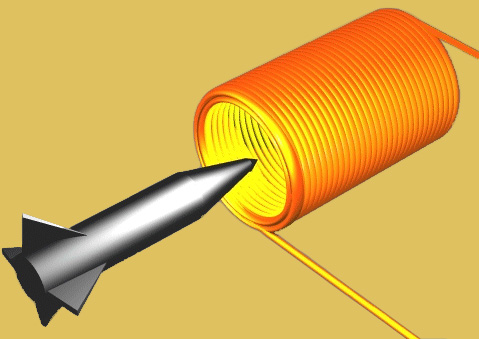
Practical Coilgun Design
Magnetic Materials
- Magnetic Materials
- Solenoid Physics
- Magnetic Field
- Force From Magnetism
- Saturation
- Saliency Ratio
- Salient Pole Motors
- Electromagnetic Guns
- Widescreen LCD
- IEEE Articles
- Bibliography
Bibliography
Here is some additional reading. These are books I've found useful, or that have been recommended to me. It is generally arranged with the best stuff at the top, and most esoteric at the bottom.
Note: These are all rather large books with only small relevent sections on coilgun topics. You would be smart to review or check them out from the library before you buy.
- "Feedback Loop Stability Analysis", by Walter S. Friauf, McGraw-Hill, ©1998,
ISBN 0-07-022844-2
Detailed coverage of loop compensation techniques and pitfalls, intended for the working engineer. This is a must-have for good design of a magnetic levitation system. It presents a graphical technique for solving transfer problems which is intuitive and useful for anyone, but a good understanding of frequency domain mathematics is helpful to understand the theory.
- "Electrical Principles for Electronics" Third Edition, by Angelo C. Gilli,
McGraw-Hill, ©1978, ISBN 0-07-023293-8
Clear and organized explanations of all basic electrical engineering concepts. Practical examples of common circuits. Each section tells you what you will learn, and then teaches you exactly that.
- "The Art of Electronics" by Horowitz and Hill, Cambridge University Press, ©1980,
ISBN 0521231515
For the practicing engineer doing circuit design, this book gives basic principles and definitions, then builds up to a very wide variety of designs. It shows by example and explanation what are good design versus bad designs. This is the best and most comprehensive of all these books. It will be of most useful to those with some EE background.
- "Practical Electricity, Part I" by Terrell Croft, McGraw-Hill,
©1923
An excellent book with practical advice for people designing coils for magnetic machines. This was written in the days when they didn't really know what magnetism was, but knew exactly how it worked through endless experimentation. They relate this hard-won knowledge in great detail.
- "Practical Transformer Design Handbook"
by Eric Lowdon, Howard Sams & Co., ©1980, ISBN 0-672-21657-4
For anyone who is designing transformers or inductors, you must get this book. It is written at a level that almost anyone with a calculator can understand, and yet is complete and very thorough.
- "Foundations of Electrical Engineering, Second Edition", by J. R. Cogdell,
Prentice Hall, ©1996, ISBN 0130927015
A textbook intended to teach electrical engineering to non-majors. Well organized with good explanations. Excellent basic facts and information on a variety of EE topics, with emphasis on basic principles.
- "The ARRL Handbook for Radio Amateurs", The American Radio Relay League
Buy any version printed in the last ten years. It has very good design material for power supplies and power output stages, and a lot of good background information on home electronics design. Lots of practical circuits that have been proven over the years. Not much on coilguns or solenoids, though.
- "Radio Handbook" 20th Edition, by William I. Orr, W6SAI, ©1975,
ISBN 0672240327.
See section 2-4. Like the ARRL Handbook, the emphasis is on practical designs and construction of a variety of communications equipment.
- "Elements of Radio", by Marcus & Horton, Prentice Hall, ©1944.
No ISBN number and it's out of print.
An excellent reference, published in 1943 and 1944 for "civilian pre-induction training" for the War Department published by Prentice-Hall. It has no ISBN or Library of Congress number, but if you can find a copy - it really has a very detailed discussion of the math and physics involved in magnetic coils, and it is worded in such a way that even officers in the military could understand it (honest!). You might be able to find a copy of this book through Prentice-Hall, or through a used bookstore.
- "Understanding Magnetism, Magnets, Electromagnetics, and Superconducting Magnets"
by Robert Wood, ©1988 by Tab books (TAB #2772) ISBN 0830607722
This is a decent reference, but is meant as an introductory text on the subject and does not go into a lot of detail.
- "Linear Electric Actuators and Generators", I. Boldea and Syed A. Nasar,
Cambridge University Press, © 1997, ISBN 0521480175
This is very advanced, really a higher-level college textbook.
| < Previous | Page 11 of 11 | Next > |
Last Update 2008-06-09
©1998-2025 Barry Hansen
©1998-2025 Barry Hansen